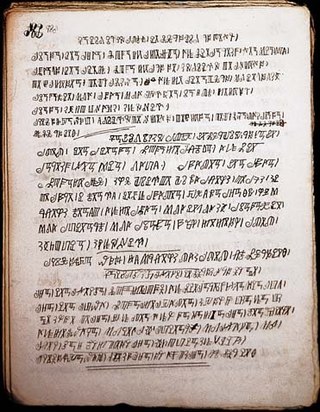Bamum language
Appearance
| Bamum | |
|---|---|
| Shüpamom | |
| ꛀꛣꚧꚳ | |
| Region | Cameroon, Nigeria |
| Ethnicity | Bamum people |
Native speakers | 420,000 (2005)[1] |
| Latin script, Bamum syllabary (being revived) | |
| Language codes | |
| ISO 639-3 | bax |
| Glottolog | bamu1253 |
 Page from a manuscript in the Bamum script | |
Bamum (Bamun: Shü Pamom [ʃŷpǎˑmə̀m] "language of the Bamum", or Shümom "Mum language"), also spelled Bamun or in its French spelling Bamoun, is an Eastern Grassfields language of Cameroon, with approximately 420,000 speakers.[1] The language is well known for its original script developed by King Njoya and his palace circle around 1895. Cameroonian musician Claude Ndam is a native speaker of the language and uses it in his music.[2]
Phonology
Bamum has tone, vowel length, diphthongs and coda consonants.
Vowels
The simple vowels are:
| Front | Central | Back | |||
|---|---|---|---|---|---|
| Unrounded | Rounded | Unrounded | Unrounded | Rounded | |
| Close | i | y | ɨ | ɯ | u |
| Mid | e | ə | o | ||
| Open-mid | ɛ | ɔ | |||
| Open | a | ||||
Bamum vowels can be normal or half-long /ˑ/.
Consonants
The consonants are:
| Labial | Alveolar | Post- alveolar/ Palatal |
Velar | Labialized velar |
Labial- velar |
Glottal | |||
|---|---|---|---|---|---|---|---|---|---|
| Plosive | Plain | Voiceless | p | t | k | kʷ | k͡p | ʔ | |
| Voiced | b | d | ɡ | ɡʷ | g͡b | ||||
| Prenasalized | Voiceless | ᵐp | ⁿt | ᵑk | ᵑkʷ | ᵑ͡ᵐk͡p | |||
| Voiced | ᵐb | ⁿd | ᵑɡ | ᵑɡʷ | ᵑ͡ᵐg͡b | ||||
| Fricative | Plain | Voiceless | f | s | ʃ | x | xʷ | ||
| Voiced | v | z | ʒ | ɣ | ɣʷ | ||||
| Prenasalized | Voiceless | ᶬf | ⁿs | ᶮʃ | |||||
| Voiced | ᶬv | ⁿz | ᶮʒ | ||||||
| Nasal | m | n | ɲ | ŋ | ŋʷ | ŋ͡m | |||
| Rhotic | r | ɹ̠ | |||||||
| Approximant | l | j | w | ||||||
Tones
Bamum has five tones[3]
| Tone | IPA |
|---|---|
| à | low |
| á | mid |
| ā | high |
| ǎ | rising |
| â | falling |
References
- ^ a b Bamum at Ethnologue (18th ed., 2015) (subscription required)
- ^ Cathy Kell (14 September 2005). "Cameroon: Claude Ndam : Committed To Culture". Retrieved 28 August 2015.
- ^ https://www.unicode.org/L2/L2007/07023-bamum-report.pdf
